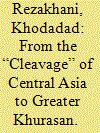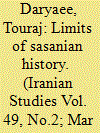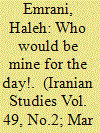| Srl | Item |
| 1 |
ID:
144713


|
|
|
|
|
| Summary/Abstract |
The history of Central Asia is normally considered peripheral to those of the civilizations that surrounded it—Marshal Hodgson termed it a civilizational “cleavage.” However, in the early Islamic period this region, particularly its southern and western parts, emerges as the dominant entity of Greater Khurasan to play a central role in the affairs of the Islamic Caliphate. This paper considers the history of the region, dubbed East Iran, before this rise to importance and proposes a different historiographical approach focusing on the developments in East Iran during the period of late antiquity and in interaction with the Sasanian Empire. It is proposed that the Greater Khurasan emerged as the result of the merging of the socio-cultural worlds of East Iran and that of the Sasanian Empire.
|
|
|
|
|
|
|
|
|
|
|
|
|
|
|
|
| 2 |
ID:
144712


|
|
|
|
|
| Summary/Abstract |
This essay discusses the position of Sasanian Studies from its inception in the late nineteenth century, to its reinvigoration at the beginning of the twenty-first century. The work also discusses the development of the field of Sasanian history and civilization vis-à-vis the three fields of Iranian, Islamic and Late Antique Studies. It is posited that Sasanians have benefited from cross-disciplinary and new historical frameworks that go beyond the traditional field of Iranian Studies, which was never as interested in the history of the period.
|
|
|
|
|
|
|
|
|
|
|
|
|
|
|
|
| 3 |
ID:
144714


|
|
|
|
|
| Summary/Abstract |
Zoroastrians of Babylonia had long lived alongside an important Jewish community whose presence in the region can be traced back to the Achaemenid period (c. 550‒330 BCE). Such long coexistence should justify an interest in the examination of cultural sharing between these two religious groups of Ērānšahr; however, it is just recently that the question of the level of cultural contact between them has become a more important source of inquiry and research by scholars of Iranian history, religious studies and Late Antiquity. The exchanges between the Jews and Zoroastrians of the Sasanian period and their impact on the character of the Babylonian Talmud have been the subject of a number of recent studies, notably by Shaul Shaked, Yaakov Elman, Geoffrey Herman and Shai Segunda, among others. The aim of this article is to contribute to these efforts by exploring the roots of some distinctly Sasanian marriage customs that transcended religious lines and were shared by the rabbinic Jews and Zoroastrians of Ērānšahr.
|
|
|
|
|
|
|
|
|
|
|
|
|
|
|
|